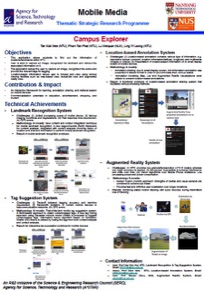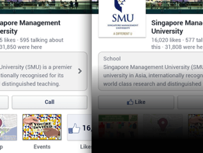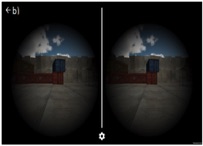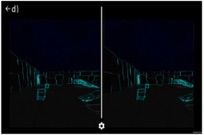Content- & Context- Aware Mobile Media Retrieval
This was a project I was involved in when I was with School of Electrical and Electronic Engineering, Nanyang Technological University. The project has developed a mobile prototype that involves using context aware capability of modern smartphones such as location aware through GPS, etc. With the developed content aware algorithms to retrieve information about the subject.
In this instance, a landmark recognition and tag suggestion prototype. The system allows the user to capture an image of a landmark (eg. Merlion) or an activity (eg. soccer) and correctly identify the landmark and provide information on it or correctly identify the activity and produces textual tags for the user to annotate the image.
I am involved in the systems development and deployment of the prototype. This project has concluded.
For more information on this project, you can contact my former supervisor in NTU, Associate Professor Yap Kim Hui.

HuMan
Profiling or fingerprinting human behavior has been widely used in context-aware and security applications.we present HuMan: History-based User Centric Memorable ApplicatioN, a new way of generating behavioral fingerprints from the usage data of cellphone users. In particular, we explore whether the generated fingerprints can be remembered by the end users or not memorable.
This project is headed by my friend, Payas Gupta. Hop over to IEEE to get the full paper:
Gupta, P.; Tan Kiat Wee; Ramasubbu, N.; Lo, D.; Debin Gao; Balan, R.K., "HuMan: Creating memorable fingerprints of mobile users," Pervasive Computing and Communications Workshops (PERCOM Workshops), 2012 IEEE International Conference on , vol., no., pp.479,482, 19-23 March 2012 doi: 10.1109/PerComW.2012.6197540 URL: http://ieeexplore.ieee.org/stamp/stamp.jsp?tp=&arnumber=6197540&isnumber=6197445

Adaptive Display Power Management for OLED Displays
New smartphones coming onto the market has now included new display technology such as the Organic Light Emitting Diode (OLED) displays. These OLED displays has since forgo the need for a backlight component found in Liquid Crystal Display (LCD) panels. Such displays has since reduce the size of smartphones with a slimmer form factor and improved power saving design. This project looks at how adaptive power management techniques can be implemented on such displays in a gaming scenario by utilizing the human aspects in reducing power consumption.
To read more on this, hop over to ACM and get the full paper:
Tan Kiat Wee and Rajesh Krishna Balan. 2012. Adaptive display power management for OLED displays. In Proceedings of the first ACM international workshop on Mobile gaming (MobileGames '12). ACM, New York, NY, USA, 25-30. DOI=10.1145/2342480.2342487 http://doi.acm.org/10.1145/2342480.2342487

Mobile Privacy/Forensic Project
In this project, we look at how to inform the user about a particular privacy leak that is occurring. The goal is not to build a better privacy leak detector, instead, we seek to bridge the gap between leak with the user. In this case, how to better inform the user of the privacy leak that is happening on the users phone.
This project is headed by my friend, Joseph Chan, hop over to this website or ping him to find out more. Or read the paper on this over at ACM:
Joseph Chan Joo Keng, Tan Kiat Wee, Lingxiao Jiang, and Rajesh Krishna Balan. 2013. The case for mobile forensics of private data leaks: towards large-scale user-oriented privacy protection. In Proceedings of the 4th Asia-Pacific Workshop on Systems (APSys '13). ACM, New York, NY, USA, , Article 6 , 7 pages. DOI=10.1145/2500727.2500733 http://doi.acm.org/10.1145/2500727.2500733

FOCUS: A usable & effective approach to OLED display power management
In this work, we present Focus, a system for effectively and efficiently reducing the power consumption of OLED displays on mobile devices (smartphones and tablets). The key idea of Focus is that we can save display power by dimming the portions of the applications and games that are less important to the user using the notion of saliency (where people tends to focus on a certain part of the screen).
The system is envision to help users when faced with a low battery scenario where Focus will allow an immediate reduction of energy use thus extending the usage time of the device till the next charge point. Focus is designed to be application agnostic and is implemented on the Google’s Android platform.
We tested Focus using 15 applications running on a Samsung Galaxy S III and show that it saves, on average, between 23 to 34% of the OLED display power and reviewed it with user study, involving 30 participants that shows that Focus , even with its dimming behaviour, is still quite usable.
This work is collaborated with Tadashi Okoshi from Keio University and my supervisors Associate Professor Archan Misra and Rajesh Krishna Balan. Please hop over to the ACM library for more information:
Kiat Wee Tan, Tadashi Okoshi, Archan Misra, and Rajesh Krishna Balan. 2013. FOCUS: a usable & effective approach to OLED display power management. In Proceedings of the 2013 ACM international joint conference on Pervasive and ubiquitous computing (UbiComp '13). ACM, New York, NY, USA, 573-582. http://doi.acm.org/10.1145/2493432.2493445

LiveLabs Urban Lifestyle Innovation Platform
LiveLabs provides a test bed for companies to run trials and experiments to test business concept or a behavioral trait, to learn more, hop over to the site. I am contributing to LiveLabs in 2 folds, one is research oriented and the production of usable software that uses the lab’s research.
In the research focus, I am specifically working on the collection of user data (permitted by the user) on the mobile platform and balancing the power needs with data fidelity. There is more research areas that LiveLabs focus on, so hop over to the LiveLabs web portal to read more.
Below are some of the Lab's deployed apps that I have contributed to:
Below are the published works that I have contributed to:
S. Gottipati et al., "Mobile platform and application research at SMU LiveLabs," 2014 Sixth International Conference on Communication Systems and Networks (COMSNETS), Bangalore, 2014, pp. 1-4.
doi: 10.1109/COMSNETS.2014.6734911,
URL: http://ieeexplore.ieee.org/stamp/stamp.jsp?tp=&arnumber=6734911&isnumber=6734849
R. K. Balan, Y. Lee, Tan Kiat Wee and A. Misra, "The challenge of continuous mobile context sensing," 2014 Sixth International Conference on Communication Systems and Networks (COMSNETS), Bangalore, 2014,
URL: http://ieeexplore.ieee.org/stamp/stamp.jsp?tp=&arnumber=6734869&isnumber=6734849

These are collection of projects I have worked on professionally (SMU, NTU).
Academic and Work Projects
FocusVR: Effective & Usable VR Display Power Management
(Paper Abastract)
In this paper, we present the design and implementation of FocusVR, a system for effectively and efficiently reducing the power consumption of Virtual Reality (VR) devices by smartly dimming their displays. These devices are becoming increasingly common with large companies such as Facebook (Oculus Rift), and HTC and Valve (Vive), recently releasing high quality VR devices to the consumer market.
However, these devices require increasingly higher screen resolutions and refresh rates to be effective, and this in turn, leads to high display power consumption costs. We show how the use of smart dimming techniques, vignettes and color mapping, can significantly reduce the power consumption of VR displays with minimal impact on usability. In particular, we describe the implementation of FocusVR in both Android and the Unity game engine and then present detailed measurement results across 3 different VR devices – the Gear VR, the DK2, and the Vive.
In addition, we present the results of 3 user studies, with 68 participants in total, that tested the usability of FocusVR. Overall, we show that FocusVR is able to save up to 80% of the display power and up to 50% of the overall system power, with negligible impact to usability.
This work is collaborated with Eduardo Cuervo with Microsoft Research and my supervisors Associate Professor Rajesh Krishna Balan.
See how it works in my Youtube Playlist
Please hop over to the ACM library for more information:
Tan Kiat Wee, Eduardo Cuervo, and Rajesh Balan. 2018. FocusVR: Effective 8 Usable VR Display Power Management. Proc. ACM Interact. Mob. Wearable Ubiquitous Technol. 2, 3, Article 142 (September 2018), 25 pages. https://doi.org/10.1145/3264952



Center for Applied Smart-Nation Analytics: Retail Analytics & Land Use Planning
This project involves analytics-driven approaches to analyse retail survaiability in the local context (Singapore). This uses data of location to determine if a retail estabilishment (Shops/Food/etc) will be able to thrive in their immediate area based on the derived analytics.
This project is a collaboration between Singapore Management University and Urban Redevelopment Authority (URA).
This project is helmed by Prof Archan and Asst-Prof Thivya, drop by their page to find out more.
I am involved in helping preprocessing the dataset as well as implementing the analytics portal.

Smart Building: Using Robust, Fine-Grained Occupancy Estimation via Combined Camera & WiFi Indoor Localization
This project uses WiFi Indoor Localization (using LiveLabs) and Camera data for occupancy estimation to effectively control the HVAC and lighting to reduce power usage on the building
This project is helmed by Post-Doc Anuradha and Prof Archan, drop by their page to find out more.
I am involved in assisting the refinement of the backend, setting up of experiments.

Fairwork: Improving Fairness and Accessibility of Crowd Work
Project Synopsis:
In this Human-Computer Interaction research, the research team will design a novel system that addresses the low wage of online crowd work—also known as online gig-economy. By using knowledge from mechanism design in the economics literature, the research team will design and develop user interfaces through machine learning models that:
1. Present information to encourage crowdsourcing requesters pay a fairer wage to online workers; and
2. Use nudging messages and information visualization to persuade workers to submit high-quality work.
This project is headed by Asst Prof Kotaro Hara and Assoc Prof Rajesh Krishna Balan, dropy by their page to find out more.
I am involved in assisting in building the platform
An example of the task: A web portal that I build that allow user to annotate objects in Point-Cloud data. Youtube Playlist

Corridor UWB
Project Synopsis:
This project utilised Ultra-Wideband (UWB) beacons for indoor localization/navigation to aid people with disabilities within public setting. (E.g. Museum, art gallery, etc)
This project is still ongoing and headed by Asst Prof Kotaro Hara.
I am involved in assisting in building the platform. See Video.
(My portion is completed, I have moved to another project, interested folks can contact Prof Kotaro Hara for details)

WiFi Indoor Localisation Project (Ongoing)
Project Synopsis:
This project performs indoor localisation without the need for fingerprinting, active internet connection and infrastructure support.
This project is ongoing and headed by Prof Rajesh Krishna Balan.
I am involved in assisting in building the proof-of-concept prototype.
(*Project is in collaboration with 3rd party entity, hence, details are redacted. Interested parties can still contact Prof Rajesh for details)

Duration: 2007-2010. Status: Concluded.
Duration: 2013.
Status: Concluded.
Best Paper Award
Duration: 2012.
Status: Concluded.
Duration: 2012.
Status: Concluded.
Duration: 2013-2019
Status: Concluded.
Duration: 2018
Status: Concluded.
Duration: 2020
Status: Concluded.
Duration: 2021
Status: Concluded.
Duration: 2022
Status: Concluded.
Duration: 2023-2024
Status: Concluded (my portion).
Duration: 2025-
Status: Ongoing.
Honorable Mention.
Duration: 2013.
Status: Concluded.